please help i have 40 mins Item 1 In the case below the orig
please help i have 40 mins
Item 1
In the case below, the original source material is given along with a sample of student work. Determine the type of plagiarism by clicking the appropriate radio button.
Original Source Material
Student Version
There is a design methodology called rapid prototyping, which has been used successfully in software engineering. Given similarities between software design and instructional design, we argue that rapid prototyping is a viable method for instructional design, especially for computer-based instruction.
References:
Tripp, S. D., & Bichelmeyer, B. A. (1990). Rapid prototyping: An alternative instructional design strategy. Educational Technology Research and Development, 38(1), 31-44.
Tripp and Bichelmeyer (1990) suggested that rapid prototyping could be an advantageous methodology for developing innovative computer-based instruction. They noted that this approach has been used successfully in software engineering; hence, rapid prototyping could also be a viable method for instructional design due to many parallels between software design and instructional design.
References:
Tripp, S. D., & Bichelmeyer, B. A. (1990). Rapid prototyping: An alternative instructional design strategy. Educational Technology Research and Development, 38(1), 31-44.
Which of the following is true for the Student Version above?
Word-for-Word plagiarism
Paraphrasing plagiarism
This is not plagiarism
Hints
Item 2
In the case below, the original source material is given along with a sample of student work. Determine the type of plagiarism by clicking the appropriate radio button.
Original Source Material
Student Version
Learning is a complex set of processes that may vary according to the developmental level of the learner, the nature of the task, and the context in which the learning is to occur. As already indicated, no one theory can capture all the variables involved in learning.
References:
Gredler, M. E. (2001). Learning and instruction: Theory into practice (4th Ed.). Upper Saddle, NJ: Prentice-Hall.
A learning theory, there, comprises a set of constructs linking observed changes in performance with what is thought to bring about those changes.
References:
Driscoll, M. P. (2000). Psychology of learning for instruction (2nd Ed.). Needham Heights, MA: Allyn & Bacon.
A learning theory is made up of a set of constructs linking observed changes in performance with whatever is thought to bring about those changes. Therefore since learning is a complex set of processes that may vary according to the developmental level of the learner, the nature of the task, and the context in which the learning is to occur, it is apparent that no one theory can capture all the variables involved in learning.
Which of the following is true for the Student Version above?
Word-for-Word plagiarism
Paraphrasing plagiarism
This is not plagiarism
Hints
Item 3
In the case below, the original source material is given along with a sample of student work. Determine the type of plagiarism by clicking the appropriate radio button.
Original Source Material
Student Version
When instructors are creating discussion board activities for online courses, at least two questions must be answered. First, what is the objective of the discussions? Different objectives might be to create a \"social presence\" among students so that they do not feel isolated, to ask questions regarding assignments or topics, or to determine if students understand a topic by having them analyze and evaluate contextual situations. Based on the response to this question, different rules might be implemented to focus on the quality of the interaction more so than the quantity. The second question is, how important is online discussions in comparison to the other activities that students will perform? This question alludes to the amount of participation that instructors expect from students in online discussions along with the other required activities for the course. If a small percentage of student effort is designated for class participation, our results show that it can affect the quality and quantity of interactions.
References:
Moore, J. L., & Marra, R. M. (2005) A comparative analysis of online discussion participation protocols. Journal of Research on Technology in Education, 38(2), 191-212.
According to Moore and Marra\'s (2005) case study, which observed two online courses, students in the first course implemented a constructive argumentation approach while students in second course had less structure for their postings. As they stated, when instructors create online discussion board activities, they must answer at least two questions. These questions are: \"What is the objective of the discussions?\" And \"How important are online discussions in comparison to the other activities that students will perform?\" According to their findings, the discussion activities that were designed based on the answers to these questions can influence the quality and quantity of interactions (Moore & Marra, 2005).
References:
Moore, J. L., & Marra, R. M. (2005) A comparative analysis of online discussion participation protocols. Journal of Research on Technology in Education, 38(2), 191-212.
Which of the following is true for the Student Version above?
Word-for-Word plagiarism
Paraphrasing plagiarism
This is not plagiarism
Hints
Item 4
In the case below, the original source material is given along with a sample of student work. Determine the type of plagiarism by clicking the appropriate radio button.
Original Source Material
Student Version
Major changes within organizations are usually initiated by those who are in power. Such decision-makers sponsor the change and then appoint someone else - perhaps the director of training - to be responsible for implementing and managing change. Whether the appointed change agent is in training development or not, there is often the implicit assumption that training will \"solve the problem.\" And, indeed, training may solve part of the problem.... The result is that potentially effective innovations suffer misuse, or even no use, in the hands of uncommitted users.
References:
Dormant, D. (1986). The ABCDs of managing change. In Introduction to Performance Technology (p. 238-256). Washington, D.C.: National Society of Performance and Instruction.
When top-down major changes are initiated in organizations, people tend to assume that training is needed to help members of the organization change their behavior. While training might help, if people in the organization lack commitment to accept the changes, they still might not do what management wants them to do.
References:
Dormant, D. (1986). The ABCDs of managing change. In Introduction to Performance Technology (p. 238-256). Washington, D.C.: National Society of Performance and Instruction.
Which of the following is true for the Student Version above?
Word-for-Word plagiarism
Paraphrasing plagiarism
This is not plagiarism
Hints
Item 5
In the case below, the original source material is given along with a sample of student work. Determine the type of plagiarism by clicking the appropriate radio button.
Original Source Material
Student Version
It is helpful to think in terms of two basic kinds of change: piecemeal and systemic. Piecemeal change leaves the structure of a system unchanged. It often involves finding better ways to meet the same needs, such as using an analogy to help your students learn the science concepts you taught in an otherwise similar manner last year. In contrast, systemic change entails modifying the structure of a system, usually in response to new needs.
References:
Reigeluth, C. M. (1999). What is instructional-design theory and how is it changing? Instructional-design theories and models: A new paradigm of instructional theory (Vol. 2, pp. 5-29). Mahwah, New Jersey: Lawrence Erlbaum.
Reiguleth (1999) mentions two different kinds of change: Piecemeal and Systemic change. Systemic change entails modifying the structure of a system, in order to meet new needs. In contrast, piecemeal change leaves the structure of a system unchanged. For example, new innovations instead of traditional methods could be used to engage students in learning.
Which of the following is true for the Student Version above?
Word-for-Word plagiarism
Paraphrasing plagiarism
This is not plagiarism
Hints
Item 6
In the case below, the original source material is given along with a sample of student work. Determine the type of plagiarism by clicking the appropriate radio button.
Original Source Material
Student Version
APT was compared with numerous extant methodologies, including the linear models approach and event history analysis. The fundamental difference between APT and these other approaches is that no particular mathematical model is assumed in APT. In APT a model is viewed simply as a temporal pattern, whereas in most other approaches parameters of a mathematical model are estimated from data in which variables are measured separately. Moreover, in APT probabilities of temporal patterns are estimated by relative frequency and duration.
References:
Frick, T. (1990). Analysis of Patterns in Time (APT): A Method of Recording and Quantifying Temporal Relations in Education. American Educational Research Journal, 27(1), 180-204.
In this study, Frick (1990) clarified the distinction between statistical linear models and Analysis of Patterns in Time (APT). Compared to the linear models approach (which includes particular mathematical models), APT is a straightforward way to create temporal maps and analyze them for recurring patterns of events. Moreover, in APT probabilities of temporal patterns are estimated by relative frequency and duration of those events.
References:
Frick, T. (1990). Analysis of Patterns in Time (APT): A Method of Recording and Quantifying Temporal Relations in Education. American Educational Research Journal, 27(1), 180-204.
Which of the following is true for the Student Version above?
Word-for-Word plagiarism
Paraphrasing plagiarism
This is not plagiarism
Hints
Item 7
In the case below, the original source material is given along with a sample of student work. Determine the type of plagiarism by clicking the appropriate radio button.
Original Source Material
Student Version
Learning is a complex set of processes that may vary according to the developmental level of the learner, the nature of the task, and the context in which the learning is to occur. As already indicated, no one theory can capture all the variables involved in learning.
References:
Gredler, M. E. (2001). Learning and instruction: Theory into practice (4th Ed.). Upper Saddle, NJ: Prentice-Hall.
A learning theory, there, comprises a set of constructs linking observed changes in performance with what is thought to bring about those changes.
References:
Driscoll, M. P. (2000). Psychology of learning for instruction (2nd Ed.). Needham Heights, MA: Allyn & Bacon.
A learning theory is made up of \"a set of constructs linking observed changes in performance with whatever is thought to bring about those changes\" (Driscoll, 2000). Therefore, since \"learning is a complex set of processes that may vary according to the developmental level of the learner, the nature of the task, and the context in which the learning is to occur, it is apparent that no one theory can capture all the variables involved in learning\" (Gredler, 2001).
Which of the following is true for the Student Version above?
Word-for-Word plagiarism
Paraphrasing plagiarism
This is not plagiarism
Hints
Item 8
In the case below, the original source material is given along with a sample of student work. Determine the type of plagiarism by clicking the appropriate radio button.
Original Source Material
Student Version
There is no other way to accommodate the facts that different children learn at different rates and have different learning needs. But to have an attainment-based rather than time-based system, we must in turn have person-based progress rather than group-based progress. And that in tum requires changing the role of the teacher to that of a coach or facilitator/manager, rather than that of dispenser of knowledge to groups of students who pass by at the ring of a bell like so many little widgets on an assembly line.
References:
Reigeluth, C. M. (1994). The imperative for systemic change. In C. M. Reigeluth & R. J. Garfinkle (Eds.). Systemic change in education. Englewood Cliffs, NJ: Educational Technology Publications.
In the new paradigm of the information age, rather than serving as a dispenser of knowledge as teachers did in the industrial age, their role must change to that of coach or facilitator of learning (Reigeluth, 1994). There is no other way to accommodate the facts that different children learn at different rates and have different learning needs (Reigeluth, 1994, p. 8).
References:
Reigeluth, C. M. (1994). The imperative for systemic change. In C. M. Reigeluth & R. J. Garfinkle (Eds.). Systemic change in education. Englewood Cliffs, NJ: Educational Technology Publications.
Which of the following is true for the Student Version above?
Word-for-Word plagiarism
Paraphrasing plagiarism
This is not plagiarism
Hints
Item 9
In the case below, the original source material is given along with a sample of student work. Determine the type of plagiarism by clicking the appropriate radio button.
Original Source Material
Student Version
There is a desperate need for theorists and researchers to generate and refine a new breed of learning-focused instructional design theories that help educators and trainers to meet those needs, (i.e., that focus on learning and that foster development of initiative, teamwork, thinking skills, and diversity). The health of instructional-design theory also depends on its ability to involve stakeholders in the design process.
References:
Reigeluth, C. M. (1999). What is instructional design theory and how is it changing? In C. M. Reigeluth (Ed.), Instructional-design theories and models volume II: A new paradigm of instructional theory. Mahwah, NJ: Lawrence Erlbaum Associates.
We \"need theorists and researchers to generate and refine learning-focused instructional design theories....\" Such theories will \"help educators and trainers to meet those needs ... that focus on learning and that foster development of initiative, teamwork, thinking skills, and diversity.\"
References:
Reigeluth, C. M. (1999). What is instructional design theory and how is it changing? In C. M. Reigeluth (Ed.), Instructional-design theories and models volume II: A new paradigm of instructional theory. Mahwah, NJ: Lawrence Erlbaum Associates.
Which of the following is true for the Student Version above?
Word-for-Word plagiarism
Paraphrasing plagiarism
This is not plagiarism
Hints
Item 10
In the case below, the original source material is given along with a sample of student work. Determine the type of plagiarism by clicking the appropriate radio button.
Original Source Material
Student Version
Memory is given a prominent role in the learning process. Learning results when information is stored in memory in an organized, meaningful manner. Teachers/designers are responsible for assisting learners in organizing that information in some optimal way. Designers use techniques such as advance organizers, analogies, hierarchical relationships, and matrices to help learners relate new information to prior knowledge. Forgetting is the inability to retrieve information from memory because of interference, memory loss, or missing or inadequate cues needed to access information.
References:
Ertmer, P. A., & Newby, T. J. (1993). Behaviorism, cognitivism, constructivism: Comparing critical features from an instructional design perspective. Performance Improvement Quarterly, 6(4), 50-71.
Memory takes an important role in the process of learning. Learning occurs when information is integrated into student memory in a structured and meaningful way. Teachers can help students learn by arranging that information in useful ways. Advance organizers could be used to assist learners to connect existing knowledge to new knowledge.
References:
Ertmer, P. A., & Newby, T. J. (1993). Behaviorism, cognitivism, constructivism: Comparing critical features from an instructional design perspective. Performance Improvement Quarterly, 6(4), 50-71.
Which of the following is true for the Student Version above?
Word-for-Word plagiarism
Paraphrasing plagiarism
This is not plagiarism
| Original Source Material | Student Version |
| There is a design methodology called rapid prototyping, which has been used successfully in software engineering. Given similarities between software design and instructional design, we argue that rapid prototyping is a viable method for instructional design, especially for computer-based instruction. References: | Tripp and Bichelmeyer (1990) suggested that rapid prototyping could be an advantageous methodology for developing innovative computer-based instruction. They noted that this approach has been used successfully in software engineering; hence, rapid prototyping could also be a viable method for instructional design due to many parallels between software design and instructional design.
|
Solution
Item 1: Word -for-word Plagiarism
Item 2: Word-for word Plagiarism
Item 3: This is not plagiarism
Item 4:Paraphrasing Plagiarism
Item 5:Word-for-word plagiarism
Item 6:Word-for-word plagiarism
Item 7:Word-for-word plagiarism
Item 8:Word-for-word plagiarism
Item 9:Word -for-Word plagiarism
Item 10:Paraphrasing plagiarism
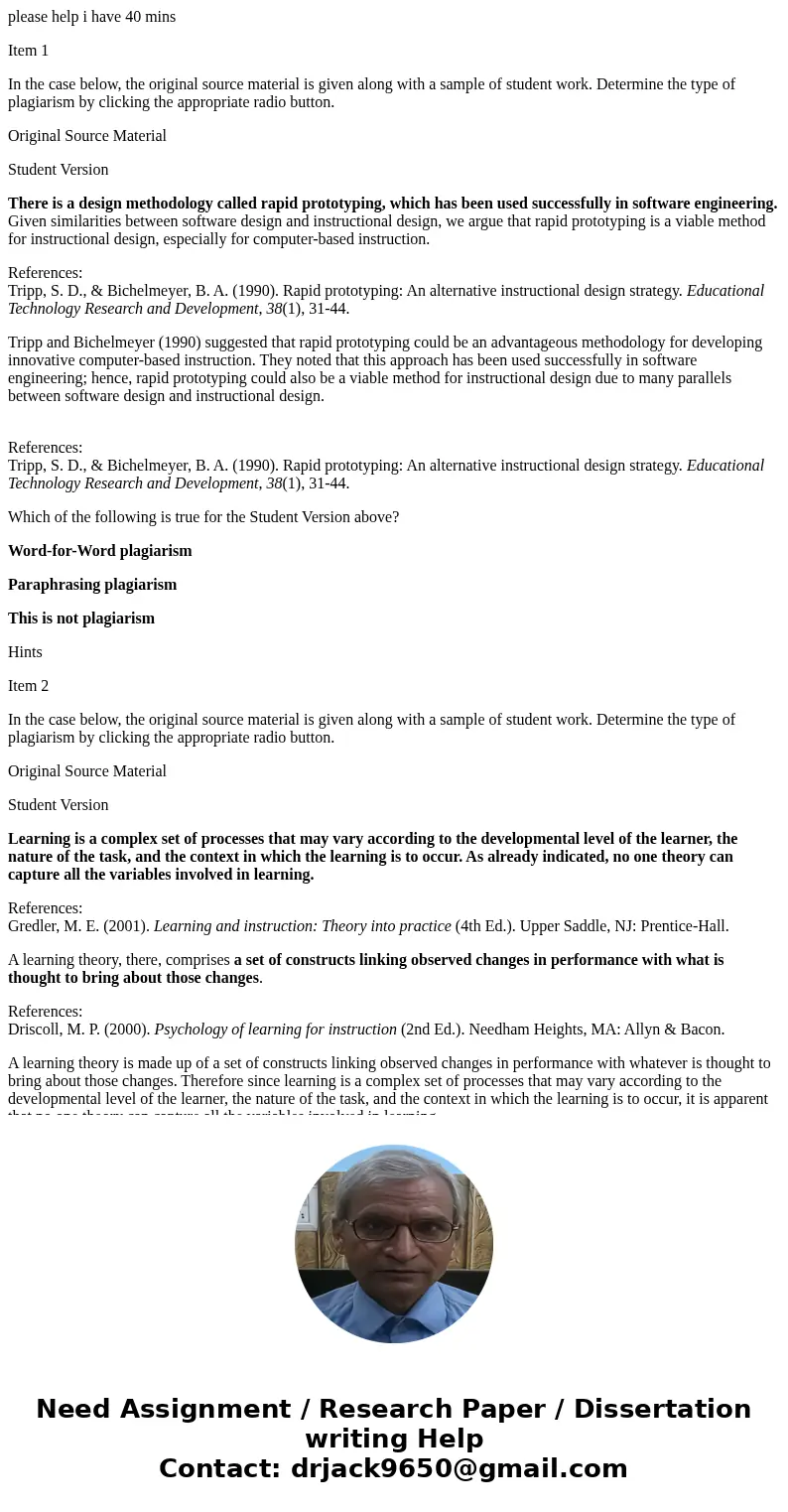
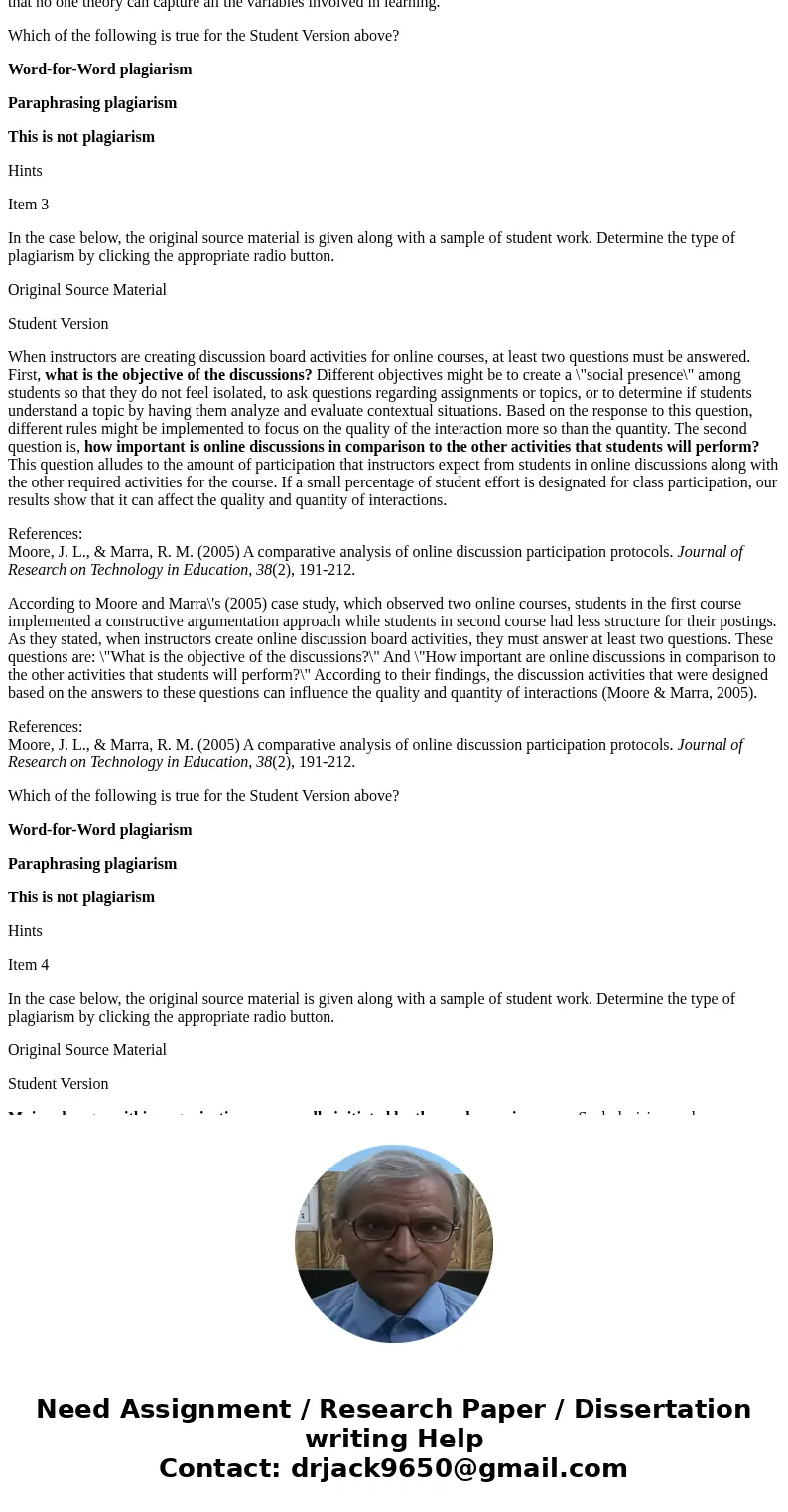
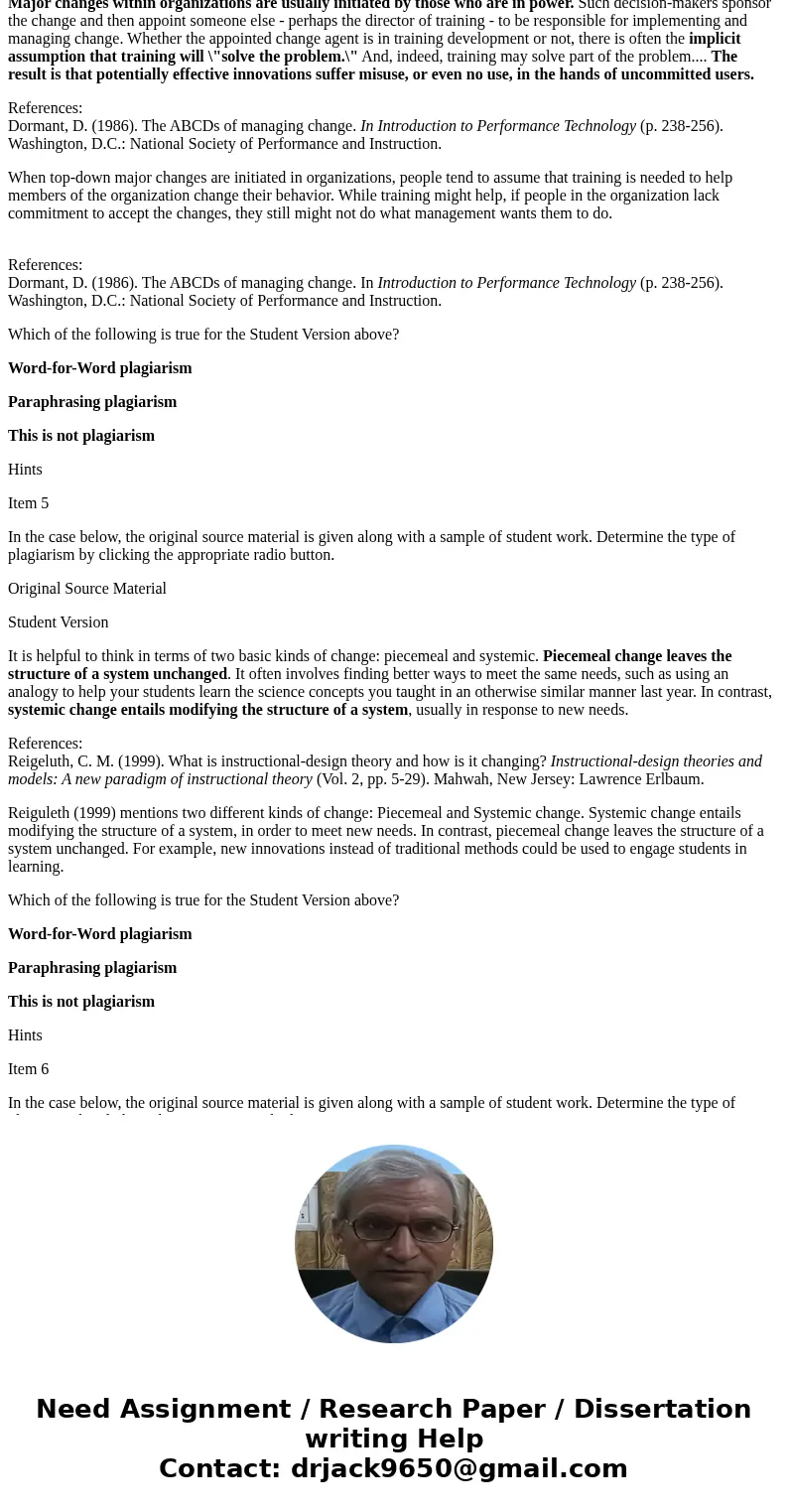
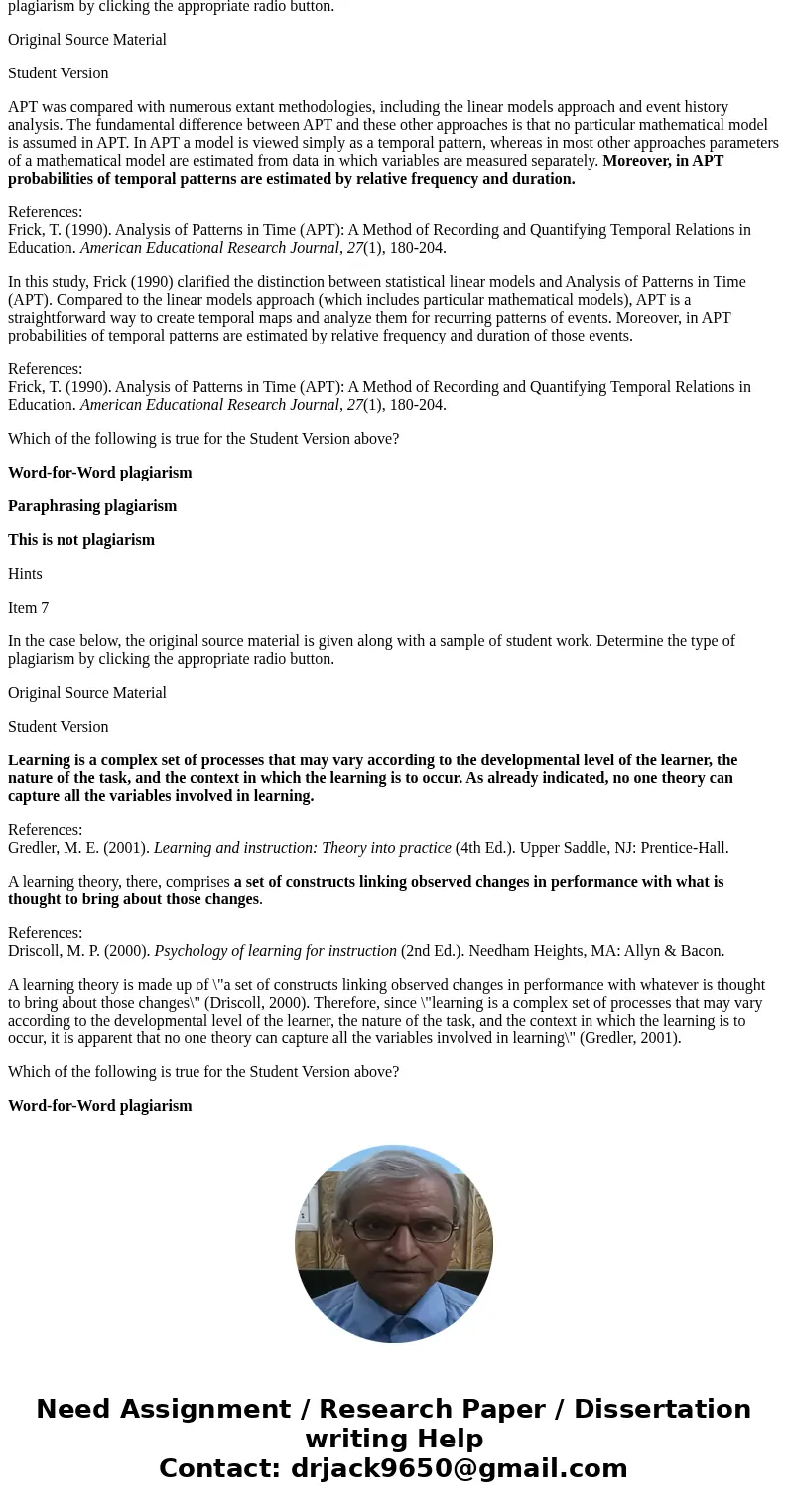
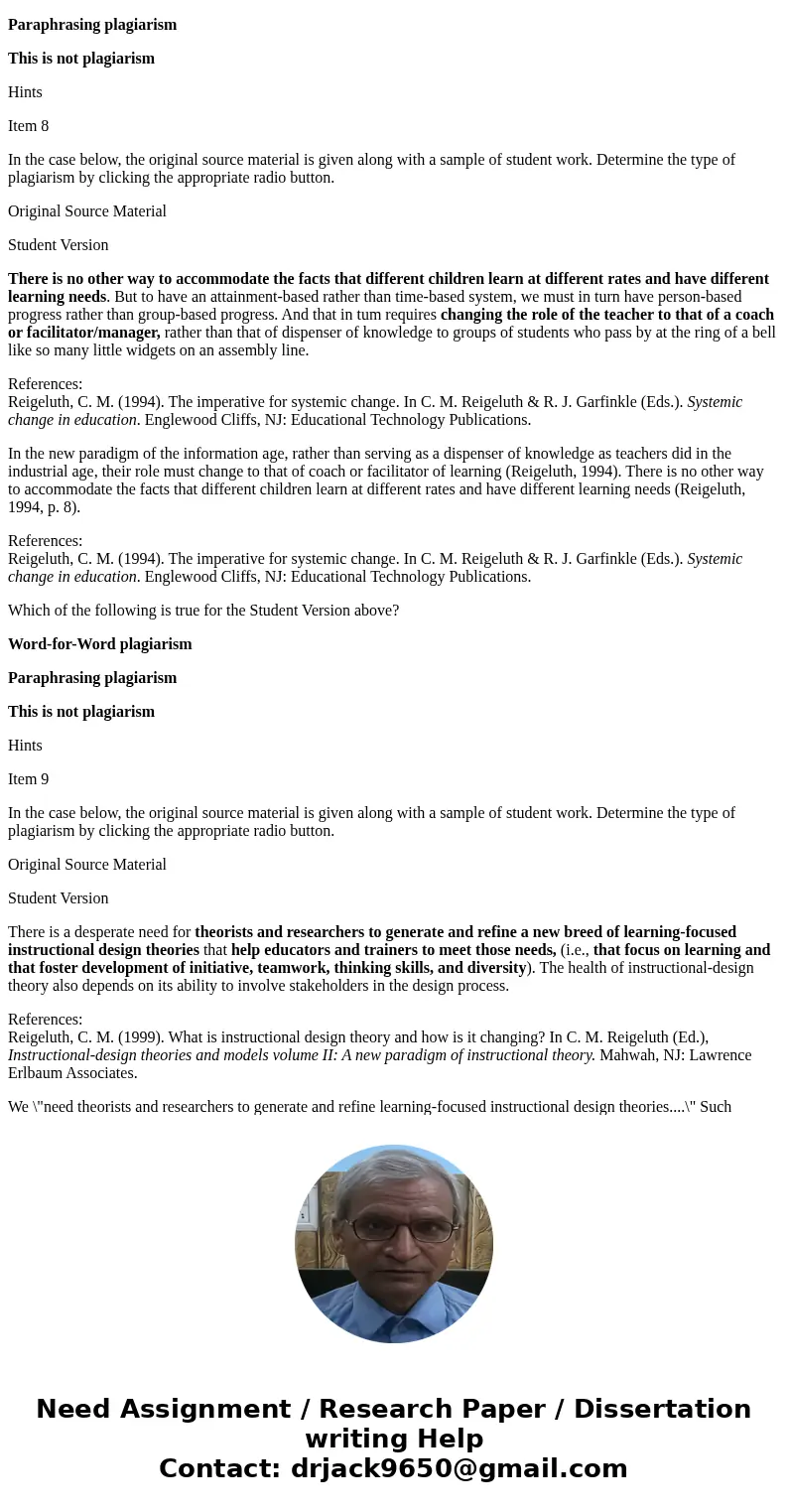
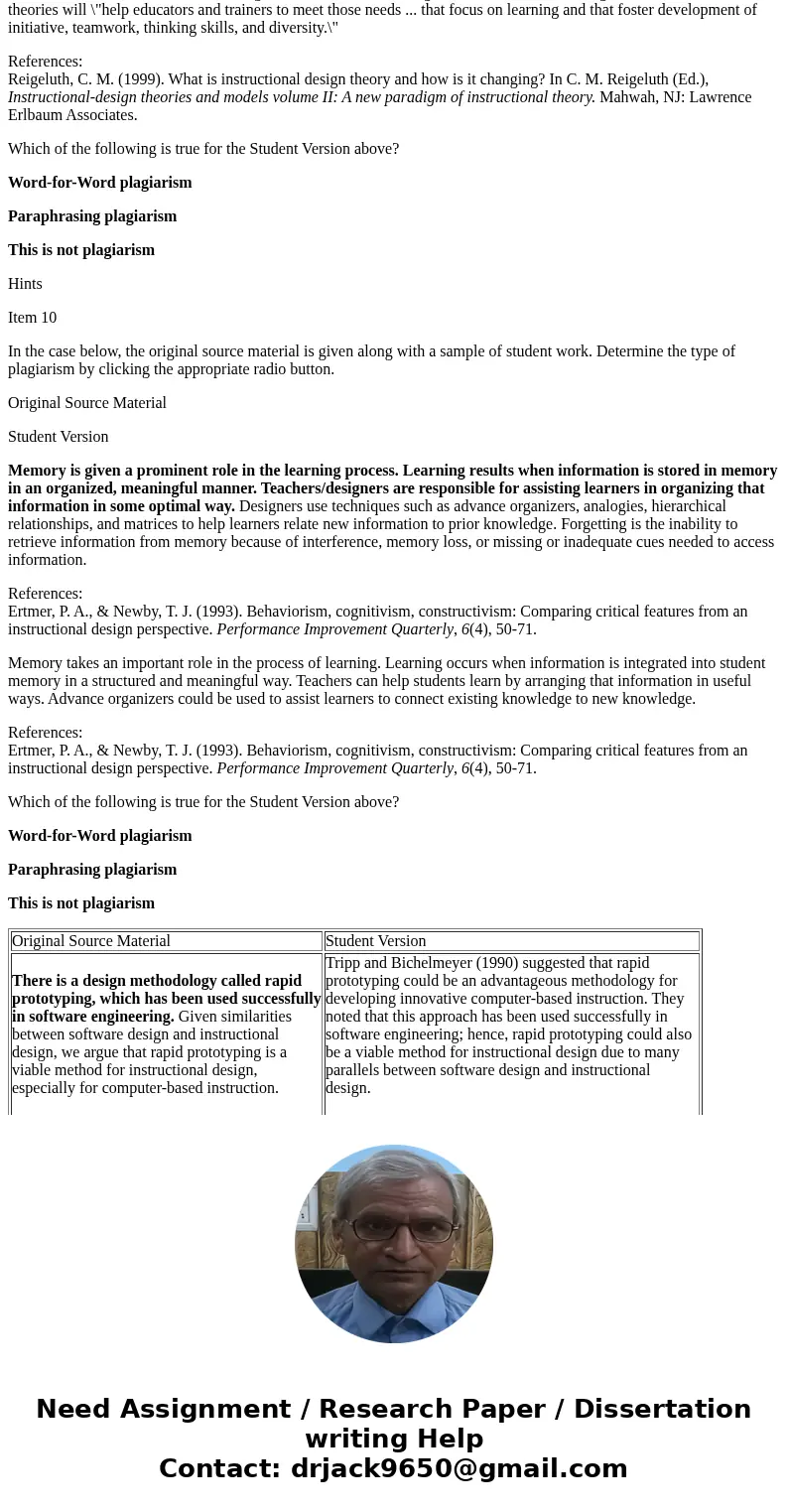
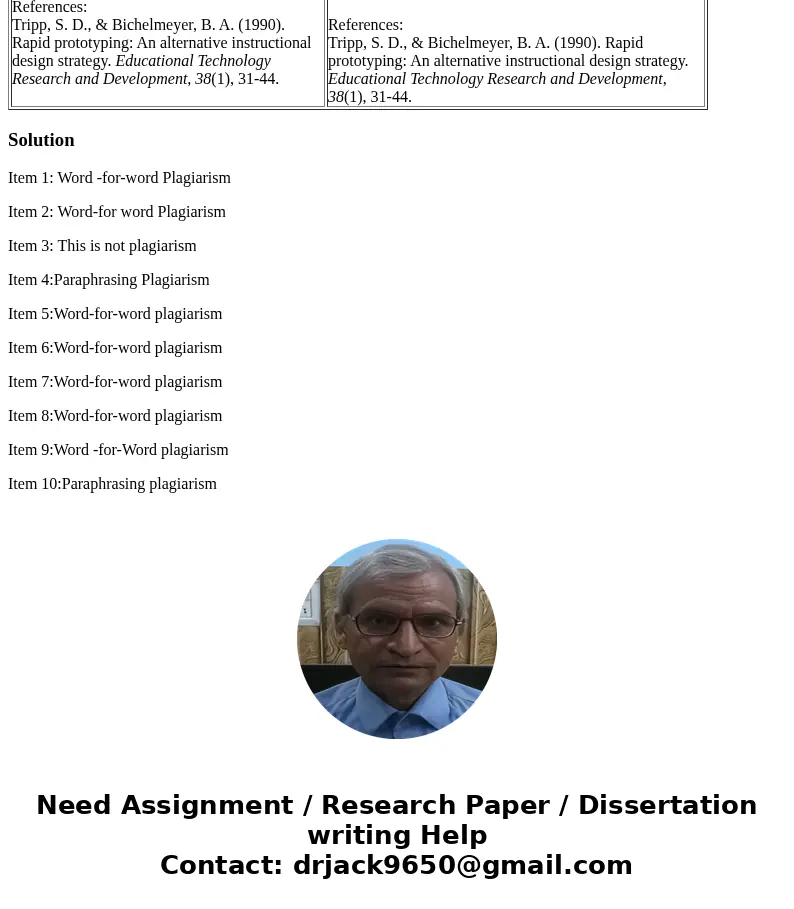
 Homework Sourse
Homework Sourse